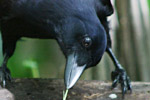
Wild male orangutan in Sumatra. Photo by: Rhett A. Butler.
Homo sapiens are not alone in experiencing a dip in happiness during middle age (often referred to as a mid-life crisis) since great apes suffer the same according to new research in the Proceedings of the National Academy of Sciences (PNAS). A new study of over 500 great apes (336 chimpanzees and 172 orangutans) found that well-being patterns in primates are similar to those experience by humans. This doesn’t mean that middle age apes seek out the sportiest trees or hit-on younger apes inappropriately, but rather that their well-being starts high in youth, dips in middle age, and rises again in old age.
“We hoped to understand a famous scientific puzzle: why does human happiness follow an approximate U-shape through life? We ended up showing that it cannot be because of mortgages, marital breakup, mobile phones, or any of the other paraphernalia of modern life. Apes also have a pronounced midlife low, and they have none of those,” explains co-author Andrew J. Oswald in a press statement.
Scientists interviewed zookeepers, volunteers, and researchers working closely with chimps and orangutans in order to assess the apes’ well-being. Using a questionnaire that measures human well-being, but was modified for great apes, the scientists found that apes experience a fall in their well-being in their late twenties or early thirties, comparable to human middle age, which is around 45-50. The simple questionnaire included questions on mood, how much enjoyment the subject gets out of socializing, and how successful they are on completing their goals.
“Our results imply that human wellbeing’s curved shape is not uniquely human and that, although it may be partly explained by aspects of human life and society, its origins may lie partly in the biology we share with great apes,” the scientists write. “These findings have implications across scientific and social-scientific disciplines, and may help to identify ways of enhancing human and ape well-being.”
The scientists write that they do not know yet why these changes occur, but current theories include changes in the brain during middle age or an evolutionary cause that selects for well-being in youth and old age.
“[Old and young] individuals, being satisfied at stages of their life where they have fewer resources to improve their lot, would be less likely to encounter situations that could be harmful to them or their kin,” the researchers theorize, but call for more studies to unpack why humans—and great apes—experience mid-life depressions.
CITATION:Alexander Weiss, James E. King, Miho Inoue-Murayama, Tetsuro Matsuzawa, Andrew J. Oswald. Evidence for a midlife crisis in great apes consistent with the U-shape in human well-being. PNAS. 2012.
Related articles
Clever crows may grasp hidden causes

(11/15/2012) Crows may be imagining more than we imagined. New research suggests certain crows make decisions based on factors they can’t see. A recent study published in the Proceedings of the National Academy of Sciences (PNAS) deepens our understanding of these crafty corvids, and could help explain how human reasoning evolved. Crows are intelligent problem solvers, capable of making hook-shaped tools to retrieve food and using multiple tools in a logical sequence. New Caledonian crows (Corvus moneduloides) are particularly adept tool users, and have often been the subject of cognitive research. In this study, the New Zealand–based researchers tested whether New Caledonian crows could trace an event back to a cause that was hidden from their view.
By imitating human voices, beluga whale may have been attempting to communicate
(10/23/2012) Five years after the death of a captive beluga whale named NOC, researchers have discovered that the marine mammal may have been trying to communicate with people by mimicking humans voices at the National Marine Mammal Foundation in San Diego. Analyzing tapes of human-like speech from the young male beluga whale, scientists writing in Current Biology note that while there have been reports of beluga whales making human like sounds before, this is the first time evidence has been captured on tape and analyzed.
Endangered turtle urinates through its mouth
(10/11/2012) One of China’s most commonly farmed turtles for consumption, the Chinese soft-shelled turtle (Pelodiscus sinensis), has a unique ability: it urinates out of its mouth. Researchers in Singapore, writing in The Journal of Experimental Biology, have discovered that the Chinese soft-shelled turtle excretes most of its urine from its mouth instead of its kidneys. They hypothesize that the turtle developed this ability in order to survive in brackish waters, which contain considerably more salt than freshwater.
Appreciating elephant individuality: a new approach to preventing conflicts with humans

(10/09/2012) To prevent conflicts between humans and elephants in developed areas, a new study shows there is much to learn from analyzing Asian elephant behavior at the individual level as opposed to population studies. Researchers have traditionally interpreted elephant behavior at the population level, looking for behavior patterns among elephants of similar ages, group sizes, and genders. Today, field researchers in India are studying elephant behavior at the individual level. Their goal is to appreciate the idiosyncrasies of individual elephants in the hopes of predicting their behavior. Nishant Srinivasaiah, of the Tata Institute of Fundamental Research and lead author of the study, told mongabay.com that it is vital “to get to know our elephants more intimately than ever before and, more importantly, to shift our focus from a population to include its individuals as well.”
Brainless slime mold uses slimy memory to navigate
(10/08/2012) How do you navigate space efficiently without a brain? Slime, according to a surprising new study in the Proceedings of the National Academy of Sciences (PNAS) of a brainless slime mold named Physarum polycephalum. Scientists at the University of Sydney have discovered that the mold secretes slime as an ‘external spatial memory’ to make sure it doesn’t end up going around in circles.
Mr. Darcy and the Manic Pixie Dream Girl: monkeys display distinct personality types

(10/01/2012) Remember the ‘man with no name’ played by Clint Eastwood in A Fistful of Dollars, Mr. Darcy in Jane Austen’s Pride and Prejudice, or the bubbly cute girl in every romantic comedy from Legally Blonde to Breakfast at Tiffany’s? Each of these characters represent an over-the-top type of human personality—loner (man with no name), aloof (Darcy), and nice (the bubbly cute girl)—but a new study in the Proceedings of the National Academy of Sciences (PNAS) finds that it’s not only humans that show such distinct types, but baboons as well. Studying 45 female chacma baboons in Botswana’s Moremi Game Reserve over seven years, the researchers found that such personality types, unrelated to social statues, helped to determine the animals’ overall sociability and the stability of their relationships.